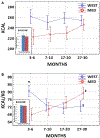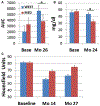Mediterranean versus Western Diet Effects on Caloric Intake, Obesity, Metabolism, and Hepatosteatosis in Nonhuman Primates
- PMID: 31012294
- PMCID: PMC7079682
- DOI: 10.1002/oby.22436
Mediterranean versus Western Diet Effects on Caloric Intake, Obesity, Metabolism, and Hepatosteatosis in Nonhuman Primates
Erratum in
-
Erratum: Mediterranean versus Western Diet Effects on Caloric Intake, Obesity, Metabolism, and Hepatosteatosis in Nonhuman Primates.Obesity (Silver Spring). 2019 Jul;27(7):1211. doi: 10.1002/oby.22529. Epub 2019 May 13. Obesity (Silver Spring). 2019. PMID: 31231955 No abstract available.
Abstract
Objective: This study aimed to determine the effects of humanlike Western and Mediterranean diets on caloric intake, obesity, metabolism, and hepatosteatosis in an established nonhuman primate model of obesity, cardiometabolic syndrome, type 2 diabetes, and atherosclerosis.
Methods: A 38-month, randomized, preclinical, nonhuman primate primary prevention trial of 38 socially housed, middle-aged adult females was conducted. The monkeys were characterized during a 7-month baseline phase while consuming chow and then randomized to either Western or Mediterranean diets; the groups were balanced on baseline characteristics. Western and Mediterranean diets were formulated to closely reflect human diets, matched on macronutrient content, with protein and fat derived largely from animal sources in the Western diet and plant sources in the Mediterranean diet. Food consumption, activity levels, energy expenditure, body composition, carbohydrate metabolism, and hepatosteatosis were measured during baseline and treatment phases.
Results: The Western diet increased caloric intake for the first 6 months and body fat, activity, energy expenditure, insulin resistance, and hepatosteatosis after 2.5 years, whereas the Mediterranean diet reduced triglyceride levels.
Conclusions: This is the first report of differential caloric intake and obesity with long-term consumption of a Western versus Mediterranean diet under controlled experimental conditions and the first experimental evidence that a Mediterranean diet protects against hepatosteatosis compared with a Western diet.
© 2019 The Obesity Society.
Conflict of interest statement
Figures




Comment in
-
Is There an Ideal Diet?Obesity (Silver Spring). 2019 May;27(5):690. doi: 10.1002/oby.22473. Obesity (Silver Spring). 2019. PMID: 31012291 No abstract available.
-
Two Bad Diets for Monkeys.Obesity (Silver Spring). 2019 Oct;27(10):1553. doi: 10.1002/oby.22588. Epub 2019 Aug 14. Obesity (Silver Spring). 2019. PMID: 31411382 No abstract available.
-
Response to "Two Bad Diets for Monkeys".Obesity (Silver Spring). 2019 Oct;27(10):1554. doi: 10.1002/oby.22587. Epub 2019 Aug 17. Obesity (Silver Spring). 2019. PMID: 31420940 No abstract available.
References
-
- Suchanek P, Poledne R, Hubacek JA. Dietary intake reports fidelity–fact or fiction? Neuro Endocrinol Lett 2011;32(suppl 2):29–31. - PubMed
-
- U.S. Department of Agriculture, Agricultural Research Service. Energy intakes: percentages of energy from protein, carbohydrate, fat, and alcohol, by gender and age. What We Eat in America, NHANES 2013–2014. https://www.ars.usda.gov/ARSUserFiles/80400530/pdf/1314/Table_5_EIN_GEN_.... Published 2016. Accessed April 6, 2018.
-
- Loh MY, Flatt WP, Martin RJ, Hausman DB. Dietary fat type and level influence adiposity development in obese but not lean Zucker rats. Proc Soc Exp Biol Med 1998;218:38–44. - PubMed
-
- Estruch R, Ros E, Salas-Salvado J, et al. Primary prevention of cardiovascular disease with a Mediterranean diet. N Engl J Med 2013;368:1279–1290. - PubMed
Publication types
MeSH terms
Grants and funding
LinkOut - more resources
Full Text Sources
Medical

